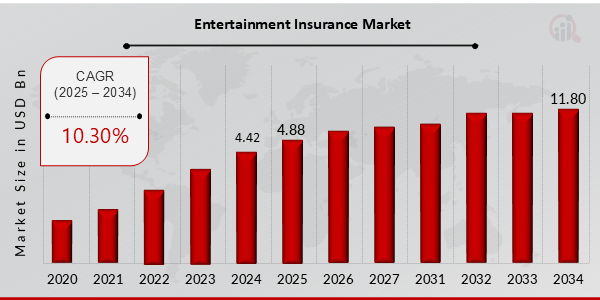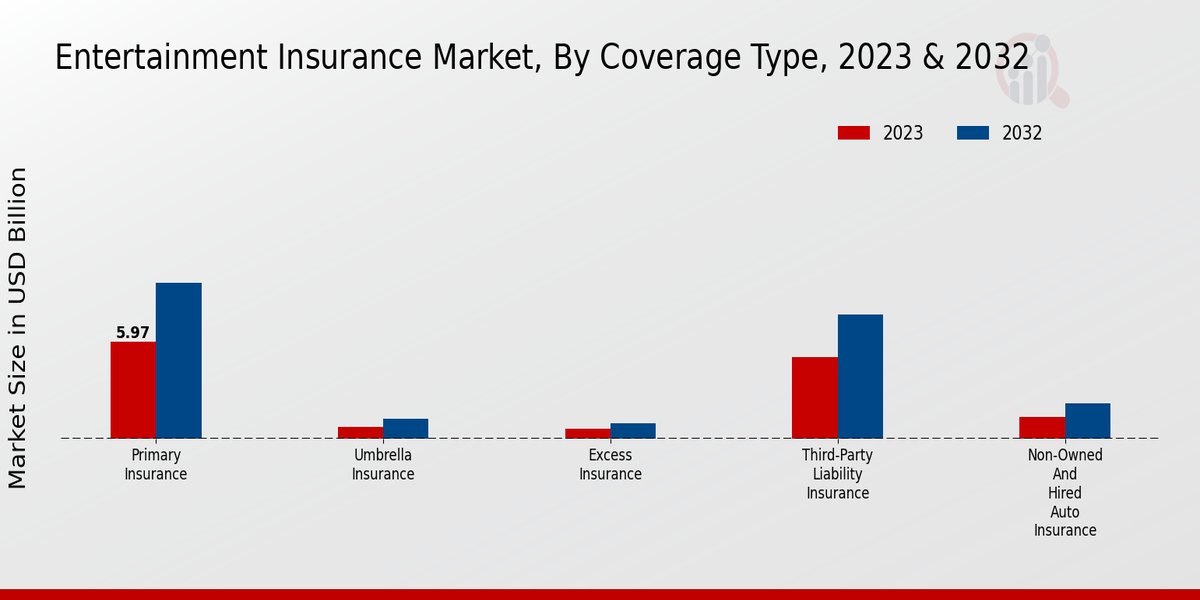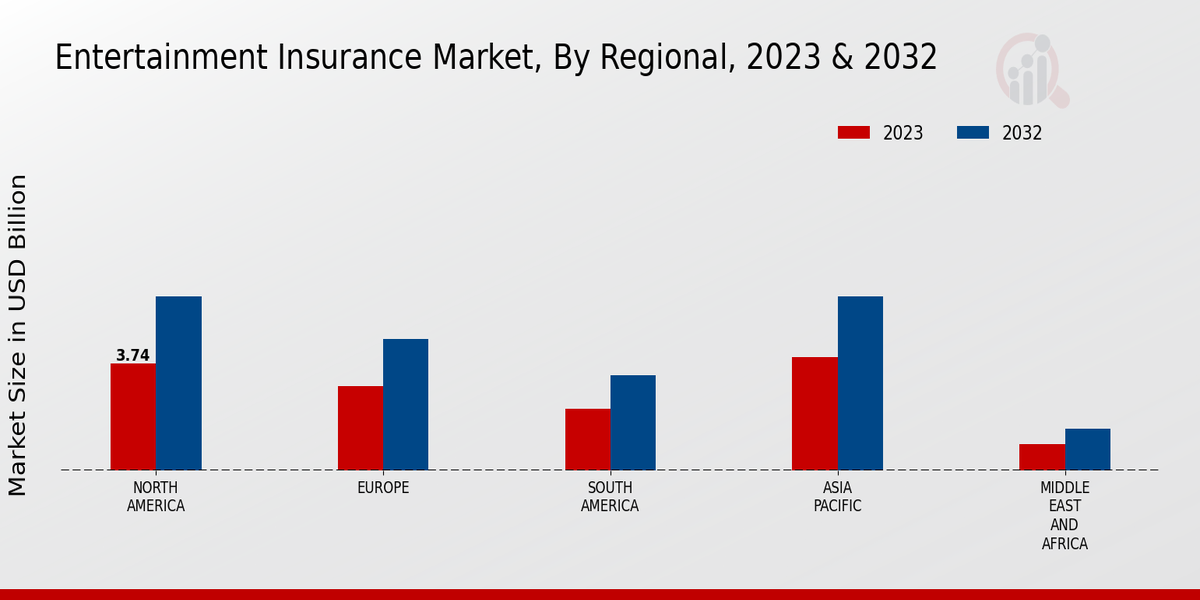Global Entertainment Insurance Market Overview
Entertainment Insurance Market Size was estimated at 4.42 (USD Billion) in 2024. The Entertainment Insurance Market Industry is expected to grow from 4.88 (USD Billion) in 2025 to 11.80 (USD Billion) till 2034, exhibiting a compound annual growth rate (CAGR) of 10.30% during the forecast period (2025 - 2034).
Key Entertainment Insurance Market Trends Highlighted
The Entertainment Insurance market is undergoing a period of rapid transformation driven by a number of key factors. These include the increasing popularity of streaming services, the rise of social media, and the growing importance of intellectual property. As a result, the market is becoming increasingly complex and competitive, and insurers are having to adapt their products and services to meet the changing needs of their customers.One of the most significant trends in the Entertainment Insurance market is the increasing popularity of streaming services.
This is having a major impact on the traditional television and film industries and is forcing insurers to rethink their approach to risk management. For example, insurers now have to consider the potential for cyberattacks on streaming platforms, as well as the risks associated with the production and distribution of original content. Another key trend is the rise of social media. This is having a major impact on the way that people consume entertainment and is creating new opportunities for insurers. For example, insurers are now offering products that cover the risks associated with social media defamation and cyberbullying.
Finally, the growing importance of intellectual property is also having a major impact on the Entertainment Insurance market. This is due to the fact that intellectual property is now a major source of revenue for many entertainment companies. As a result, insurers are now offering products that cover the risks associated with intellectual property infringement, such as copyright and trademark infringement.

Source: Primary Research, Secondary Research, MRFR Database and Analyst Review
Entertainment Insurance Market Drivers
Rising Demand for Entertainment Content
The entertainment industry is witnessing a rising demand for high-quality content across a variety of platforms, including movie theaters, live events, and streaming services. The growth is determined by OTT technology gaining momentum, the increasing number of smart devices, and rising disposable income in many developing economies, among other factors. As entertainment companies increase their investment in creating premium-grade content, demand for entertainment insurance grows as well, aimed at protecting these companies from losing money in case of production or distribution problems.
Advancements in Technology
The development of technologies in the modern period is changing the entertainment industry, thus contributing to the appearance of new forms of entertainment and their delivery. The wide use of virtual reality, augmented reality, and artificial intelligence serves the role of enhancing the immersive nature and developing the interactiveness of perceptions for consumers. Simultaneously, these changes presuppose new risks for entertainment companies, such as exposure to data breaches, intellectual property theft, and product liability.Entertainment insurance can become certified to provide coverage for these emerging risks, allowing organizations to continue innovating and responding adequately to the changing industry environment.
Increased Regulatory Compliance
Governments around the world are implementing stricter regulations on the entertainment industry to protect consumers and ensure fair competition. These regulations cover areas such as data privacy, content censorship, and labor laws. Failure to comply with these regulations can result in significant fines, legal action, and reputational damage. Entertainment insurance can provide coverage for regulatory compliance costs, including legal fees, fines, and penalties.By doing so, it helps entertainment companies mitigate risks associated with non-compliance and maintain their reputation in the eyes of consumers and regulators.
Entertainment Insurance Market Segment Insights
Entertainment Insurance Market Coverage Type Insights
The Coverage Type segment is a crucial aspect of the Entertainment Insurance Market, offering a range of specialized insurance policies tailored to the unique risks faced by various entertainment entities. Primary Insurance serves as the foundational coverage, providing protection against common liabilities and property damage. Umbrella Insurance extends this protection by offering additional coverage beyond the limits of primary policies, ensuring comprehensive risk management. Excess Insurance provides an extra layer of coverage when the limits of primary and umbrella policies are exhausted, safeguarding against catastrophic losses.Third-Party Liability Insurance plays a vital role in protecting entertainment businesses from legal claims arising from injuries or damages caused to third parties during events or productions.
Non-Owned and Hired Auto Insurance, on the other hand, covers vehicles that are not owned by the entertainment entity but are used in their operations, ensuring financial protection in case of accidents or damages. In 2023, the Entertainment Insurance Market revenue from Coverage Type is projected to reach USD 13.69 billion, with a steady growth trajectory anticipated in the coming years.This growth is attributed to the increasing demand for specialized insurance solutions, growing awareness of risk management, and the expanding entertainment industry worldwide.

Source: Primary Research, Secondary Research, MRFR Database and Analyst Review
Entertainment Insurance Market Policy Type Insights
The Entertainment Insurance Market is segmented based on Policy Type into Individual Policies and Group Policies. In 2023, the Individual Policies segment held a larger market share, accounting for approximately 65% of the Entertainment Insurance Market revenue. The significant growth of this segment can be attributed to the increasing popularity of individual entertainment activities such as concerts, sporting events, and film screenings.
Group Policies, on the other hand, are expected to witness a steady growth rate during the forecast period, owing to the rising demand for comprehensive insurance coverage by entertainment companies and organizations.The Entertainment Insurance Market data indicates that the Group Policies segment is projected to reach a market valuation of approximately USD 7.5 billion by 2032, exhibiting a CAGR of 5.6% over the forecast period.
Entertainment Insurance Market Industry Vertical Insights
The Industry Vertical segment of the Entertainment Insurance Market holds significant importance, accounting for a large portion of the market revenue. Among the key industry verticals are Film and Television, Music, Sports, Live Events, and Theatre. Each vertical presents unique insurance needs and growth opportunities. Film and Television: This segment is expected to witness substantial growth owing to the increasing production of films and television shows ly. The rising demand for streaming services and the proliferation of content platforms are driving the expansion of this segment. Music: The Music industry vertical is fueled by the growing popularity of music streaming and the emergence of new artists. The need for insurance coverage for musical instruments, tours, and performances is driving growth in this segment. Sports: The Sports industry vertical is expanding rapidly due to the increasing popularity of sporting events and the rising number of professional athletes.
Insurance coverage for sports teams, venues, and athletes is essential to mitigate risks associated with injuries, accidents, and liability. Live Events: The Live Events industry vertical encompasses concerts, festivals, and other large-scale events.The growth of this segment is attributed to the increasing demand for live entertainment experiences. Insurance coverage for event organizers, performers, and attendees is crucial to protect against potential risks. Theatre: The Theatre industry vertical is experiencing steady growth as more people attend live performances. The need for insurance coverage for theatres, productions, and actors is driving demand in this segment. Overall, the vertical industry segment of the entertainment insurance market presents significant growth opportunities.The diverse needs of each vertical require tailored insurance solutions, making it an attractive market for insurers.
Entertainment Insurance Market Peril Type Insights
The Peril Type segment of the Entertainment Insurance Market is expected to exhibit significant growth in the coming years, with a market value surpassing USD 25.5 billion by 2032. Property Damage is a key peril type, accounting for a sizable portion of the market, driven by the need to protect against physical damage to entertainment properties, such as studios, theaters, and equipment. Liability insurance is another crucial peril type, safeguarding against legal claims arising from accidents or injuries during entertainment events. Business Interruption insurance is essential for mitigating financial losses caused by disruptions to entertainment operations due to unforeseen events.
Weather-related perils, such as storms and floods, pose significant risks to the entertainment industry, leading to increased demand for weather insurance. Cyber insurance is gaining prominence as entertainment companies become more reliant on technology and face the threat of cyber attacks. These peril types collectively contribute to the comprehensive protection of the entertainment industry, ensuring financial stability and minimizing risks.
Entertainment Insurance Market Regional Insights
The regional segmentation of the Entertainment Insurance Market market includes North America, Europe, APAC, South America, and MEA. North America held the largest market share in 2023 and is expected to maintain its dominance throughout the forecast period. The growth in this region can be attributed to the presence of a large number of entertainment companies, favorable government policies, and increasing consumer spending on entertainment activities.
Europe is the second-largest market for entertainment insurance, followed by APAC, South America, and MEA.The APAC region is expected to witness the highest growth rate during the forecast period due to the increasing popularity of entertainment activities and the growing middle class in countries such as China and India. South America and MEA are expected to experience moderate growth in the entertainment insurance market due to the presence of a large population base and the increasing adoption of digital entertainment services.

Source: Primary Research, Secondary Research, MRFR Database and Analyst Review
Entertainment Insurance Market Key Players And Competitive Insights:
Major players in the entertainment insurance market are constantly striving to gain a competitive edge by introducing innovative products and services, expanding their geographical reach, and forming strategic partnerships. Leading Entertainment Insurance Market players are focusing on developing customized insurance solutions to meet the specific needs of different entertainment industry segments. The Entertainment Insurance Market development is driven by the increasing demand for entertainment content, the rise of streaming services, and the growing popularity of live events.
The Entertainment Insurance Market Competitive Landscape is expected to remain highly competitive in the coming years, with established players and new entrants vying for market share. A leading company in the Entertainment Insurance Market is Chubb. The company offers a comprehensive range of entertainment insurance products, including production insurance, general liability insurance, and errors and omissions insurance. Chubb has a strong presence and a reputation for providing high-quality insurance solutions. The company's financial strength and stability make it a reliable partner for entertainment businesses of all sizes. Chubb is committed to providing innovative insurance solutions that meet the evolving needs of the entertainment industry.
A competitor company in the Entertainment Insurance Market is AIG. The company offers a wide range of entertainment insurance products, including production insurance, cast insurance, and equipment insurance. AIG has a strong network and a team of experienced underwriters who are knowledgeable about the entertainment industry. The company's financial strength and stability make it a reliable partner for entertainment businesses. AIG is focused on providing customized insurance solutions that meet the specific needs of its clients.
Key Companies in the Entertainment Insurance Market Include
- Liberty Mutual
- ACE
- Generali Generali Group
- XL Catlin
- AXA
- Travelers
- Lloyd's of London
- Munich Re
- Zurich
- Swiss Re
- Chubb
- AIG
- Berkshire Hathaway
- Hiscox
Entertainment Insurance Market Industry Developments
The entertainment insurance market size was valued at USD 13.69 billion in 2023 and is projected to reach USD 21.5 billion by 2032, exhibiting a CAGR of 5.14% during the forecast period. The market growth can be attributed to the rising demand for entertainment insurance due to the increasing production of films, television shows, and other entertainment content. Recent news developments include the launch of new insurance products tailored to the specific needs of the entertainment industry, such as policies covering cyber risks and intellectual property infringement. Furthermore, the increasing popularity of online streaming services is driving the demand for entertainment insurance as production companies seek to protect their investments in original content.
Entertainment Insurance Market Segmentation Insights
-
Entertainment Insurance Market Coverage Type Outlook
- Primary Insurance
- Umbrella Insurance
- Excess Insurance
- Third-Party Liability Insurance
- Non-Owned and Hired Auto Insurance
-
Entertainment Insurance Market Policy Type Outlook
- Individual Policies
- Group Policies
-
Entertainment Insurance Market Industry Vertical Outlook
- Film and Television
- Music
- Sports
- Live Events
- Theatre
-
Entertainment Insurance Market Peril Type Outlook
- Property Damage
- Liability
- Business Interruption
- Weather
- Cyber
-
Entertainment Insurance Market Regional Outlook
- North America
- Europe
- South America
- Asia Pacific
- Middle East and Africa
| Report Attribute/Metric |
Details |
|
Market Size 2024
|
USD 4.42 Billion
|
|
Market Size 2025
|
USD 4.88 Billion
|
|
Market Size 2034
|
USD 11.80 Billion
|
|
Compound Annual Growth Rate (CAGR)
|
10.30% (2025-2034)
|
| Report Coverage |
Revenue Forecast, Competitive Landscape, Growth Factors, and Trends |
|
Base Year
|
2024
|
|
Market Forecast Period
|
2025-2034
|
|
Historical Data
|
2020-2023
|
| Market Forecast Units |
USD Billion |
| Key Companies Profiled |
Liberty Mutual, ACE, Generali Generali Group, XL Catlin, AXA, Travelers, Lloyd's of London, Munich Re, Zurich, Swiss Re, Chubb, AIG, Berkshire Hathaway, Hiscox |
| Segments Covered |
Coverage Type, Policy Type, Industry Vertical, Peril Type, Regional |
| Key Market Opportunities |
Live Streaming and Virtual Events Coverage Content Protection and Cybersecurity Production Delays and Cancellations Social Media and Online Reputation Emerging Technologies and Innovation |
| Key Market Dynamics |
Rising demand for live events Increasing popularity of streaming services Growing awareness of risk exposure Technological advancements Stringent regulations |
| Countries Covered |
North America, Europe, APAC, South America, MEA |
Frequently Asked Questions (FAQ) :
The Entertainment Insurance Market is expected to reach a valuation of USD 11.80 billion by 2034, exhibiting a CAGR of 10.30% during the forecast period (2025-2034).
North America and Europe are the dominant regions in the Entertainment Insurance Market, accounting for a significant share of the revenue. Asia-Pacific is anticipated to witness substantial growth over the forecast period, driven by the increasing number of entertainment events and the growing popularity of digital entertainment platforms.
Entertainment Insurance provides coverage for a wide range of applications within the entertainment industry, including film and television production, live events, music festivals, sports events, and other entertainment-related activities.
Prominent players in the Entertainment Insurance Market include Chubb, AIG, Allianz, AXA, Zurich, Liberty Mutual, Travelers, and Berkshire Hathaway Specialty Insurance.
The growth of the Entertainment Insurance Market is primarily driven by the increasing demand for entertainment content, the rise of digital entertainment platforms, and the growing popularity of live events. Additionally, factors such as the increasing awareness of risk management and the availability of customized insurance solutions are contributing to market expansion.
The Entertainment Insurance Market faces challenges such as the impact of economic downturns on entertainment spending, intense competition, and the emergence of new technologies that disrupt traditional entertainment models.
Emerging trends in the Entertainment Insurance Market include the adoption of parametric insurance, the use of data analytics for risk assessment, and the development of new insurance products tailored to the specific needs of the entertainment industry.
The Entertainment Insurance Market is projected to exhibit a CAGR of 10.30% over the forecast period (2025-2034), reaching a valuation of USD 11.80 billion by 2034.
Key factors influencing the growth of the Entertainment Insurance Market include the increasing demand for entertainment content, the rise of digital entertainment platforms, the growing popularity of live events, and the increasing awareness of risk management.
North America and Europe currently dominate the Entertainment Insurance Market. However, Asia-Pacific is expected to witness significant growth over the forecast period due to the increasing number of entertainment events and the growing popularity of digital entertainment platforms in the region.

















